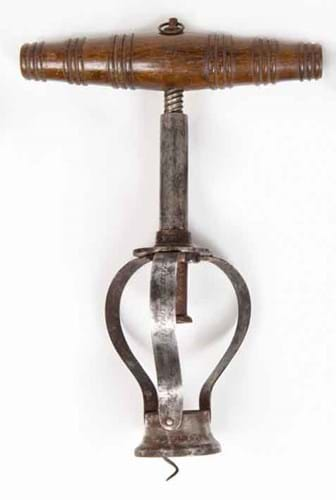"My improvements in the construction of cork-screws consist in the adaptation or application of springs. Introducing the worm into the cork compresses the bow springs and brings them in to a state of tension. When the elastic force of the springs exceeds that of the friction between the cork and the bottle it will cause the cork to be drawn up a short distance, when it can be easily drawn out in the ordinary way."
The third British 19th century corkscrew patent, filed by Charles Osborne of 11 Upper Temple Street in Birmingham on July 2, 1839, has long been regarded as royalty among collectors - in part because just a single example was known. Osborne died of consumption aged 28 on January 3, 1840, just six months after his patent was granted - his death certificate listing him as a 'corkscrew manufacturer'.
Efforts to pry the 'unique' Charles Osborne patent, pictured in the reference work British Corkscrew Patents from 1795 by Fletcher Wallis, away from its English collector have long failed. But helixophiles - the name given to collectors who marvel at the creativity and ingenuity that has gone into designing a single-purpose implement - have long suspected there was another out there somewhere. In November two more surfaced on either side of the English Channel.
Collectors' view
In the first week of November an 'ancien tire bouchon' appeared on the French version of eBay. It shared the bowed springs (but not the ratchet mechanism) of the 1839 Osborne in British Corkscrew Patents and was marked to the collar Soho Patent and By Her Majesty's Royal Letters, suggesting it was made by Matthew Boulton. The corkscrews made by Boulton to Rev Samuel Henshall's design of 1795 are similarly marked.
What did collectors who had spotted it think it was worth? After 37 bids it closed at 7.43am on November 14 at €22,410 ($28,000). It was very close to the auction record for a corkscrew which has traditionally been held by examples of the second (1842) model designed by Robert Jones and Son of Cheapside, Birmingham. In 1998, prior to the digital age, one of these sold for £16,000 (plus 15% buyer's premium) at Christie's South Kensington, but since then examples have made up to $35,000 in specialist online auctions.
Engraved
More was to follow when lot 929 of Reeman Dansie's sale in Colchester on November 26 was picked up by the search engines. This model was almost exactly like the version pictured in British Corkscrew Patents. It has no patent markings but the same inscription engraved to one of the springs: Made from the Iron Shoe that was taken from a pillar that was 656 Years in the Foundation of Old London Bridge. It includes the name J. Ovenston, 72 Gt. Titchfield St., London - a descendant of the vendor who, listed as a cabinetmaker and upholsterer, sold 'relics' fashioned from the London landmark when it was dismantled in 1831. A pair of similarly-inscribed nutcrackers (£480) and a sarcophagus form tea caddy (£400) were sold by the auctioneers in 2009 followed by a pair of boot pulls (£50) and a steel King's type corkscrew with turned oak handle (£1200) in June 2012.
The Reeman Dansie lot was not in perfect condition (the ratchet mechanism did not function), but the interest was enormous, with several people in the room specifically for the corkscrew and four phone lines primed. Bidding rose slowly to £11,000 (well above the £400-600 estimate) before accelerating in increments of £1000 as a bidder in the room and a phone exchanged blows. Prompting a round of applause, the hammer fell to the buyer in the room - "a European collector" - at a record-smashing £40,000 (plus 20% buyer's premium).






